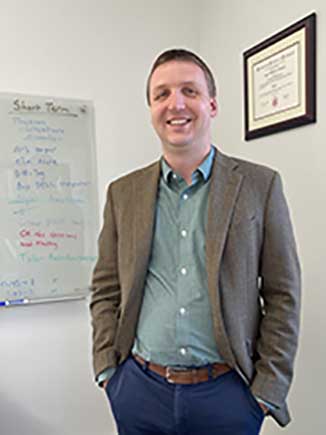Two-photon Exchange and the Goal of Describing the Charge Inside a Proton
Axel Schmidt
Assistant Professor, Dept. of Physics
Director of Undergraduate Studies
George Washington University
Wed, September 25, 2024 - 4:00 PM The proton, the familiar building block of atoms, carries one unit of positive charge, which is distributed, like vapor in a cloud, in a region about 10^-15 m across. By measuring the nature of this distribution, nuclear physicists hope to learn about the fundamental strong nuclear force which holds the proton together. Decades worth of electron scattering experiments have given us a preliminary picture of this distribution; however, incompatibility of results from two different experimental methods (Rosenbluth separation and polarization transfer) have muddied the waters. One hypothesis is that a phenomenon called "two-photon exchange," assumed to have negligible impact on electron scattering may actually be biasing the two types of measurements in different ways. A trio of experiments in the last decade attempted to measure two-photon exchange directly using positrons, and while the results were inconclusive, two-photon exchange is still the most viable hypothesis to explain inconsistencies in the distribution of the proton's charge. In this talk, I will review the history of the two-photon exchange hypothesis, describe the efforts the OLYMPUS experiment in Germany to test it, and highlight the case for adding the capability of accelerating positrons to Jefferson Lab here in Virginia. Getting a firm experimental handle on two-photon exchange is important for the success of the ambitious program of proton structure measurements planned for the future Electron Ion Collider.
The proton, the familiar building block of atoms, carries one unit of positive charge, which is distributed, like vapor in a cloud, in a region about 10^-15 m across. By measuring the nature of this distribution, nuclear physicists hope to learn about the fundamental strong nuclear force which holds the proton together. Decades worth of electron scattering experiments have given us a preliminary picture of this distribution; however, incompatibility of results from two different experimental methods (Rosenbluth separation and polarization transfer) have muddied the waters. One hypothesis is that a phenomenon called "two-photon exchange," assumed to have negligible impact on electron scattering may actually be biasing the two types of measurements in different ways. A trio of experiments in the last decade attempted to measure two-photon exchange directly using positrons, and while the results were inconclusive, two-photon exchange is still the most viable hypothesis to explain inconsistencies in the distribution of the proton's charge. In this talk, I will review the history of the two-photon exchange hypothesis, describe the efforts the OLYMPUS experiment in Germany to test it, and highlight the case for adding the capability of accelerating positrons to Jefferson Lab here in Virginia. Getting a firm experimental handle on two-photon exchange is important for the success of the ambitious program of proton structure measurements planned for the future Electron Ion Collider.
If you have any questions about the Colloquium Series, would like to request disability accommodations or would like to make a donation please contact the Physics Department, cua-physics@cua.edu or call (202) 319-5315.
